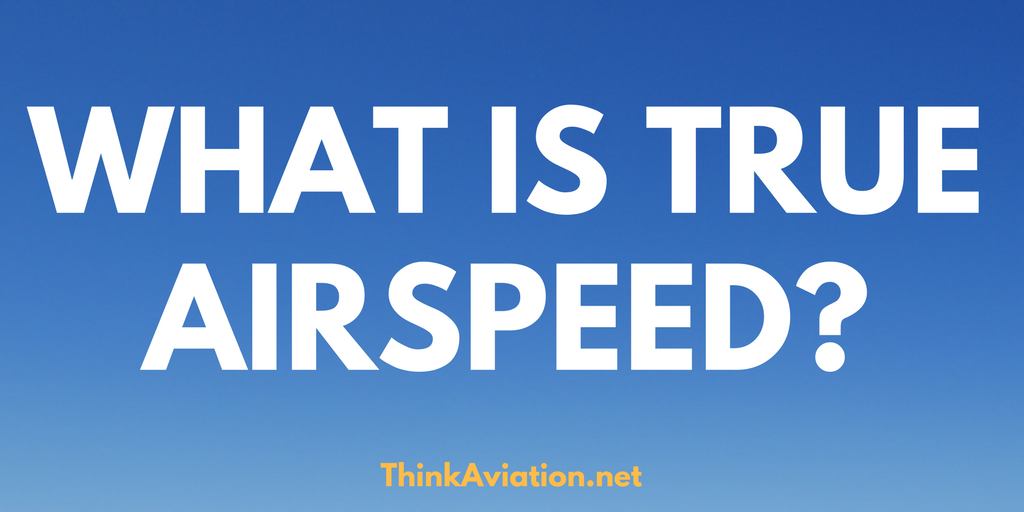
I have a confession. Even after several thousand hours, I have a hard time defining the different types of airspeed.
The good thing is you don’t need to know the exact definition to be a good pilot, but you do need to know how to use it. True airspeed is important because it is used extensively in flight planning and it’s tied to aircraft performance.
What is true airspeed?
Here are three book definitions.
- True airspeed is the airspeed of an aircraft relative to undisturbed air.
- It’s the aircraft speed relative to the airmass in which it’s flying.
- It’s calibrated speed adjusted for altitude and non-standard air.
Yeah, I agree, these definitions are kind of hard to wrap your head around so, let’s break it down.
True airspeed, unlike indicated airspeed and calibrated airspeed (IAS/CAS) accounts for altitude and non-standard temperatures. Which, let’s face it, is everytime your fly! When’s the last time you flew at sea level, 29.92 and 15 deg C? I don’t think I ever have.
That’s where true airspeed comes in.
True airspeed accounts for these differences in pressure and temperature to give you an accurate or “true” airspeed.
At altitudes close to sea level, temperatures close to the International Standard Atmosphere and slow speeds, your Indicated Airspeed, and True Airspeed are very close to each other.
But when you get hotter, colder, go faster or higher, the two differ from each other dramatically.
For example, at 25,000 feet the King Air I fly shows 180 knots indicated, but I file for 280 knots true airspeed on my flight plan. That’s a 100-knot difference between the two! The altitude and temperature are what drives the two apart.
Note, if I the airmass I flew through had no wind, my ground speed and true airspeed would be identical.
How do you measure and/or calculate TAS?
It can’t be measured directly with any kind of instrumentation. But you can calculate it based on the current conditions.
GPS equipped aircraft will calculate and display TAS for you. Consult your manual on how to get to the display as each system is slightly different. That’s won’t help you when you are planning your flight, though.
Why do you calculate TAS?
Your FAA flight plan requires a true airspeed. You will use TAS when you plan for your flight because it is a reflection of how fast you will actually fly through the air on any given flight.
Because TAS takes into account altitude and temperature, it is a “true” reflection of your actual speed. Therefore, it makes sense to use it on a flight plan.

However, the one time you would need to know your TAS in flight is if your speed goes up or down more than 10 knots or 5%. It’s prudent, therefore, to keep an eye on your true airspeed. It will only vary if you change a power setting or throw out the ice vanes (anti-ice) equipment.
Where do I get those numbers? Check it out:
The AIM requires you report to ATC or FSS anytime the average true airspeed (at cruising altitude) varies by 5 percent or 10 knots (whichever is greater) from that filed in the flight plan.
So, if you normally fly at 10o knots true airspeed, you need to report if you are flying faster than 110 knots or if you slowed to below 90 knots. Sometimes you will need to reduce your speed due to turbulence or if you have an emergency.
Do not confuse true airspeed with the ground speed. Ground speed varies enormously with the winds at altitude. Your true airspeed will stay the same, but the ground speed will slow or speed up with a headwind and tailwind.
Always check your actual TAS against the TAS you filed on your flight. As you gain more experience you will start to learn what kind of true airspeed your aircraft gets at certain power settings.
Different ways to find TAS:
You always need to calculate your TAS for VFR and IFR flight plans. I will outline 2 techniques.
Technique #1: The E6B
You have to use an E6B because you need to take into account the temperature and altitude. I personally don’t use a manual E6B anymore. I only use an iPhone app. Here’s the one I use.

You need several pieces of information before you can do the TAS calculation.
- Choose your cruise altitude.
- Get the barometric setting from the current METAR.
- Look up your expected cruise speed from your operator’s manual. Or, if you’ve been flying for a while you will know this number.
- Then you need the temperature at the planned altitude. This is a little bit trickier. You can find it easily on Foreflight. If you don’t have Foreflight, keep scrolling to find temperatures and winds at altitude without Foreflight.
Enter in all the information and the app will calculate your True Airspeed. Round that number off and that is the number you will use on your flight plan.
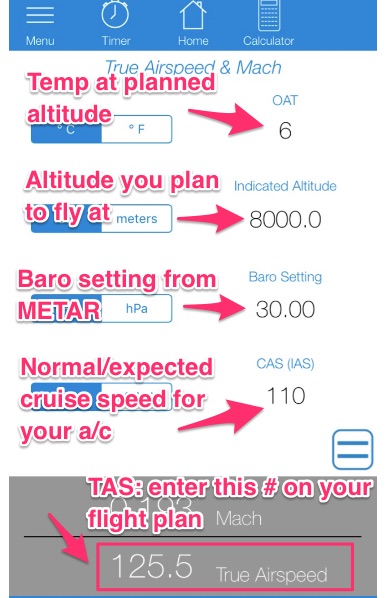
How to find outside air temperature for a given altitude:
Here’s how you find it through the National Weather Service’s Aviation Weather Center site.
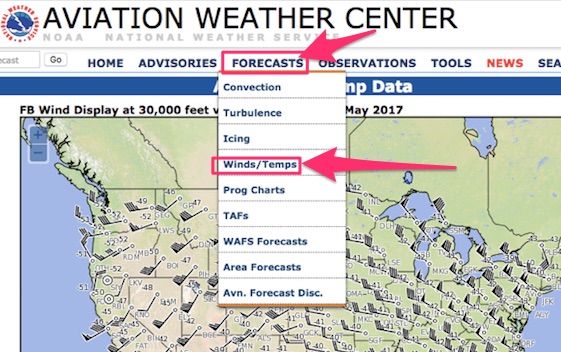
Once you get on the “Forecasts,” “Winds/Temps” page, scroll to the very bottom for this chart:
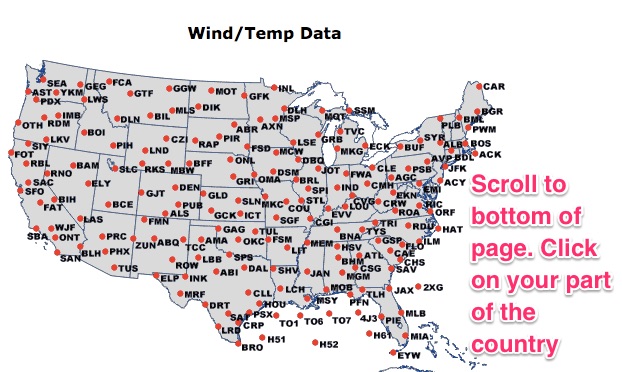
Click on your area of the country and you will get this confusing looking chart:
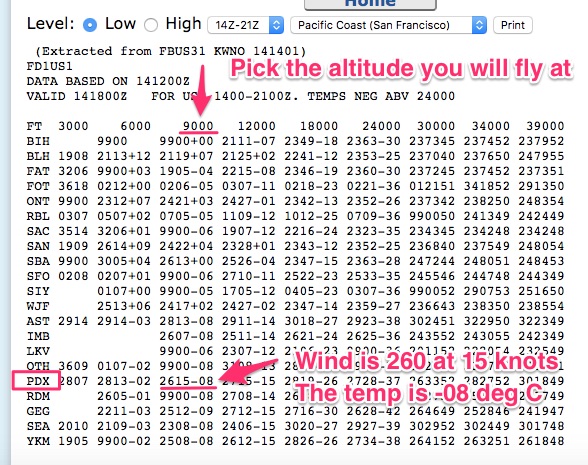
Find your nearest airport on the far left and your cruise altitude then read to the right.
It takes a little deciphering. The first two numbers are the wind direction, the second two are the speed and the last two are the temperature.
The negative means it’s a “minus” degrees Celcius. None of the numbers are in Fahrenheit, ever.
You’ll never get the wind speed and temperature below 3000 feet. You don’t need that information at altitudes below 3,000 feet because your TAS and IAS will almost always equal each other. But if you want to calculate TAS below 3000 feet use the local METAR.
Technique #2: Use a Rule of Thumb
Don’t want to go through all that hassle? Use a rule of thumb to find true airspeed. You have 5% or 10 knots to play with before you have to report to ATC, right? You can afford to be off a couple of knots.
True Airspeed Rule of Thumb:
For any altitude flown above 3,000 feet, add 3 knots per 1000′ to get your (rough) true airspeed.
Example: if you fly at 100 knots and you go up to 10,000 feet you’ll get a TAS of 121 kts. (10,000′-3000’=7,000’… 7*3=21kts… 100kts + 21kts=121 kts)
I do have a disclaimer that this won’t hold up when the temp gets really cold or hot, but it’ll be close enough.
As you can see you can get as detailed as you want.
Just remember you only have 10 knots or 5% to play with, so you should get your true airspeed on your flight plan as close as you can get it.
After a while, you will learn what TAS you aircraft flies at, so you don’t need to be as meticulous.
Knowing the definition isn’t as important as knowing how to find the information required to accurately calculate your true airspeed.